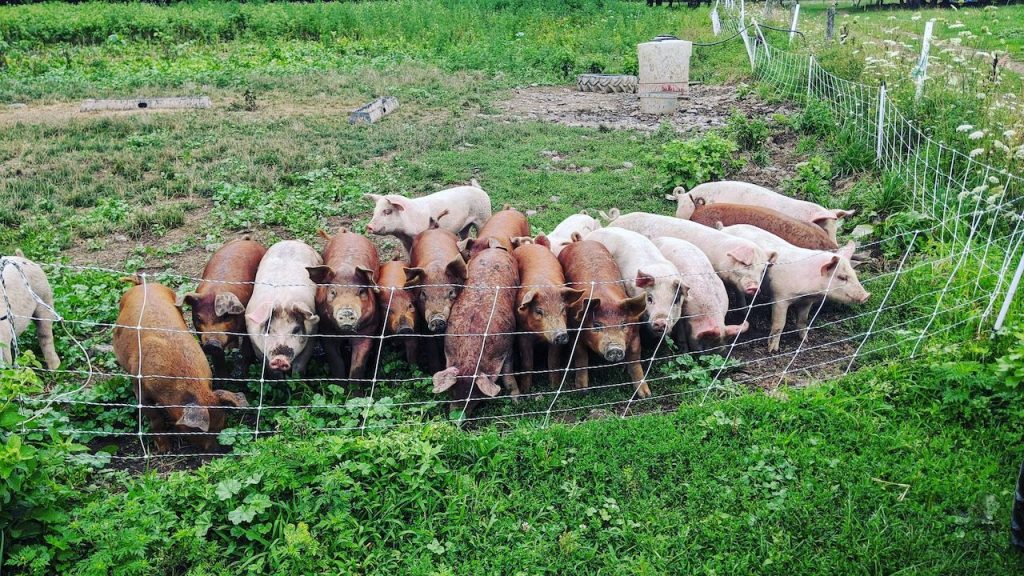It’s two bushels of tomatoes this year. And two bushels of green beans. And two bushels of peppers, when they’re ready.
I’ve doubled-down on the canning and freezing. We have more mouths to feed here at home, and we’re not planning on going out in public much once it gets cold.
Doubling down on home cooking seems to be one of the themes for 2020. We feel it at the farm: the increased demand for meat. We feel it when we run down to Barbers’ vegetable stand: the long lines, exacerbated by the six foot distances.
We felt it back in the spring, when the state sent out its new regulations for selling at the farmers’ market: Maintain distances, wear masks, no one is to touch the produce except the farmer, find ways to make transactions as quick as possible. And then there was the real stickler: Minimize conversation.
Small farming feels like it has become a fast-paced business overnight.
I wasn’t drawn to this for the fast pace.
I got into grad school under the wing of a rural sociologist, Tom Lyson, who was obsessed with the civic side of small-scale agriculture: the conversations that took place at farmers’ markets, the debates that might happen at the check-out at a road stand, the cooking pointers that might be passed along to the next generation as they bought their first roasting chicken or eggplant. It was this side of farming, more than the feed rations, crop production plans or animal science, that pulled me back to my family’s business.
Tom’s theories were purely intuitive for me. The art of conversation, the willingness to sit for a spell and listen or talk while stopping by to borrow tools, pick up a dozen eggs, or drop off some extra zucchini, were instilled in me by my parents and neighbors. The exchanges are one part entertainment, one part education, and two parts social currency. This is how we debate local laws, persuade on political issues, learn who needs help, elect officials, find good doctors, discover home remedies, expand our culinary skills, or just ease the pressure on our spirits with laughter and story telling.
But suddenly these things aren’t supposed to matter in our industry. This is supposed to be the year for the small farmers to make their money. People finally want what we have to sell: safe, nutritious, local food I’m hearing about farmers tripling their customer base, selling out, brokering in products to meet demand. I’m hearing story after story of gangbusters business.
But our family farm didn’t jump into the frenzy. We pulled out of the farmers market. Rather than ramp up, we stepped back, then kept with our original production plan. Forty years on the land has taught us there’s no such thing as a boom economy in farming. Increase the flock size too much, and you increase the likelihood of disease. Increase the production and sales pressure too much, and you increase the rate of physical breakdown, fatigue-related injuries and stress. There’s a sweet spot where the the travails are manageable, we can rebound from loss and disruptions with relative alacrity, and we’re able to keep peace amongst ourselves (for the most part). The sweet spot is the secret to our endurance. But it’s not very sexy, and it excludes us from bragging rights about gross revenues.
And, admittedly, I’ve had my bouts of insecurity about it. I can’t help fearing every now and then that we’re missing the boat, overlooking a rare opportunity, failing to get ahead while the getting’s good.
But on Saturday, from the window at my griddle, I watch Mom mask up and weave in and around the cafe tables spread from our patio, out to the lawn, then through the parking lot; talking to people from their car windows, talking to people at their tables, talking to them beside their tailgates. She’s doing what she’s done for the past forty years: using her farm to cultivate community and spark discourse. She’s doing what Tom Lyson thought made the small farm so important to the vitality of rural America. As Bob and I cook food inside to nourish our customers’ bellies, she stands at a distance and nourishes their spirits with conversation.
Watching her, I’m reminded that this is why we do what we do. Our work is to nourish and restore on multiple levels. And right now, before the snow flies and pushes us all back to quarantine-level isolation, that social work is as important as growing food. Watching her reminds me that we small farmers needn’t produce more and more and more until we become big farmers. To rebuild the broken food system, we just need more small farmers operating in the sweet spot.
So, we probably aren’t going to launch ahead with record profits this year. We might be up a little, which will be nice. If we’re lucky, we’ll be ahead just enough so that we can afford to shut the cafe for the winter when the risk of Covid infection is too high. And hopefully we’ll have canned enough green beans and tomatoes, sold enough meat, dished out enough cafe meals & good conversation to keep us, and our customers, warm until sunshine, spring weather and maybe some good breakthroughs allow us back out again. But meanwhile, as summer wanes, it’s time to serve up more farm breakfasts, pull more lattes, enjoy more chatter, herd the turkeys to fresh pasture, feed the pigs, move the sheep, and then put up the peppers. It’s just another day in the life of the sweet spot.

Bravo!! You guys amaze me every day. You found the secret happiness that so many of us just let slip by.
Love to all!
We try…it’s not always easy…But maybe that fact alone is the key to the happiness?